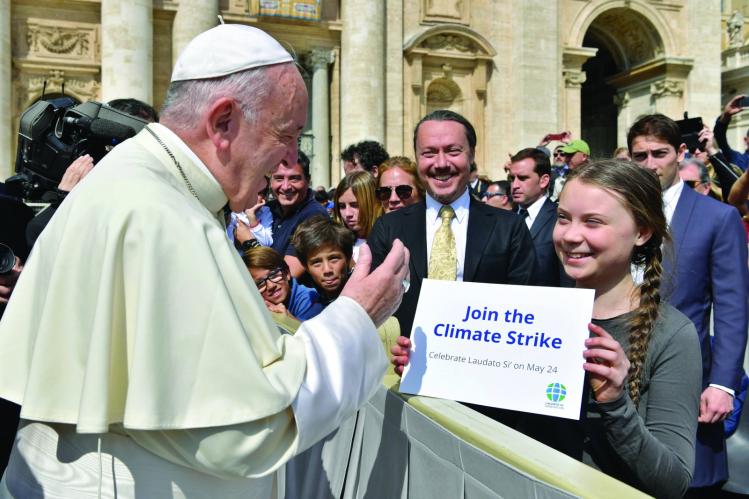
All eyes have been on Greta Thunberg, the sixteen-year-old Swedish activist, as she begins her journey across the Atlantic in a carbon-neutral sailing ship to speak at a meeting of the United Nations on climate change. Air travel generates tons of carbon emissions. She won’t do it. And we like watching her not do it.
Thunberg first came to public notice about a year ago, via a personal protest in front of the Swedish Parliament. This in turn inspired a worldwide series of strikes by school children, called Fridays for Future, drawing more than a million participants. Nearly 1,600 strikes in 118 countries were planned for this spring, including fifty strikes organized by Laudato Si’ Generation, a youth initiative under the umbrella of the Global Catholic Climate Movement. As the clock runs out on the opportunity to turn back some of the worst effects of climate change, Greta, as her supporters call her, has been incredibly brave, focused, and passionate about her cause. In recognition of her efforts, she has been nominated for a Nobel Prize, and affirmed by Pope Francis. She has become an icon of the children-and-youth movement demanding concrete action for sustainability in response to the climate crisis.
On one level, the Greta Thunberg phenomenon conforms to a well-known pattern: one highly motivated individual, present at the right place and time in history, ignites a movement and becomes its public face. The kindling was ready—mounting concern about the environment, and a growing sense of the need for change—and she struck the match. The timing is what matters.
Yet her impact on our imagination also, in an important sense, depends on her youth. Children and young people in the present era have taken on both a real and a symbolic role with respect to how adults grapple with the challenge of climate change and environmental degradation. Young people have increasingly come into the spotlight as the ones whose future hangs in the balance, and whose energy has the potential to rouse the world to action.
Youth activism in the area of ecology, and more specifically climate change, is hardly new. The Sunrise Movement, Extinction Rebellion, the Green New Deal, and other bold initiatives have been fueled by the ideals and energy of young people. At World Youth Day in Panama, a Climate Manifesto was presented to Cardinal Luis Antonio Tagle of Manila, who received it on behalf of the Catholic Relief and Development agency Caritas Internationalis. Greta’s Fridays for Future may have brought schoolchildren out into the streets, but she is hardly the only youthful leader pressing for an ecologically sustainable world.
In the United States, a defining moment in identifying the climate crisis with the fate of young people came about in 2015 through the court case of Juliana v. United States. It laid out the claim, on behalf of twenty-one young plaintiffs directly affected by the ill effects of climate change, that they have a right to a sound and stable environment. Julia Olson, the plaintiffs’ lead lawyer, recalls that she was radicalized about climate change while she was pregnant: “There is something about carrying life inside your body that is transformative and gives you a different kind of perspective on the world.”
It’s clear why young people are at the forefront of the agitation: future generations will pay the bill of past and present environmental fecklessness. The children and teens of today will be the ones saddled with extreme weather, air pollution, species extinctions, scarcity of clean water, and the rising oceans of tomorrow, not to mention the costs of social unrest and displacement around the world due to ecological degradation.
Can youth save us from ourselves? This is the part I am not so sure about. Their energy, and the very fact that they do not despair of changing the habits and structures that have landed us in this mess, provide the world with something precious. As Fr. Joshtrom Isaac Kureethadam, coordinator of the ecology and creation sector of the Vatican’s Dicastery for Promoting Integral Human Development, said at a recent conference at Creighton University, they give us hope. But if the adult world simply watches and applauds, and does not engage in its own reciprocal work and sacrifice to reduce carbon emissions, little will change. The protests, manifestos, and Greta’s trip across the ocean in a little carbon-neutral boat will go down in history as theater rather than prophecy. What matters, in the end, is the principle that Pope Francis articulated in Laudato si’: intergenerational solidarity. Each generation holds the earth in trust for the next; each generation is responsible for passing it on intact.
Please email comments to [email protected] and join the conversation on our Facebook page.
Share
Previous Story
Divorce, Annulment & Communion
Next Story
Letters | The bishops and sex abuse, Catholics on the margins & more